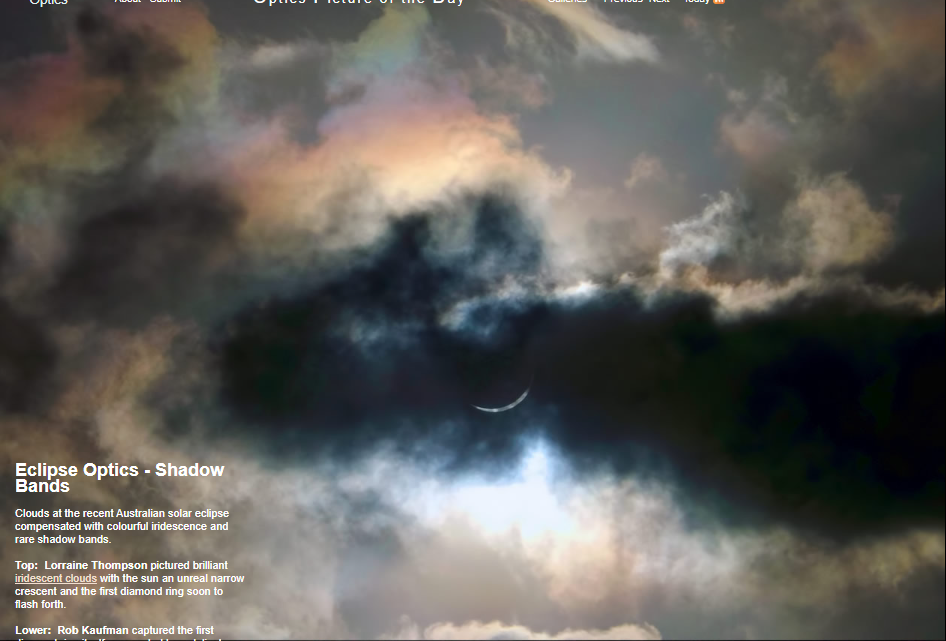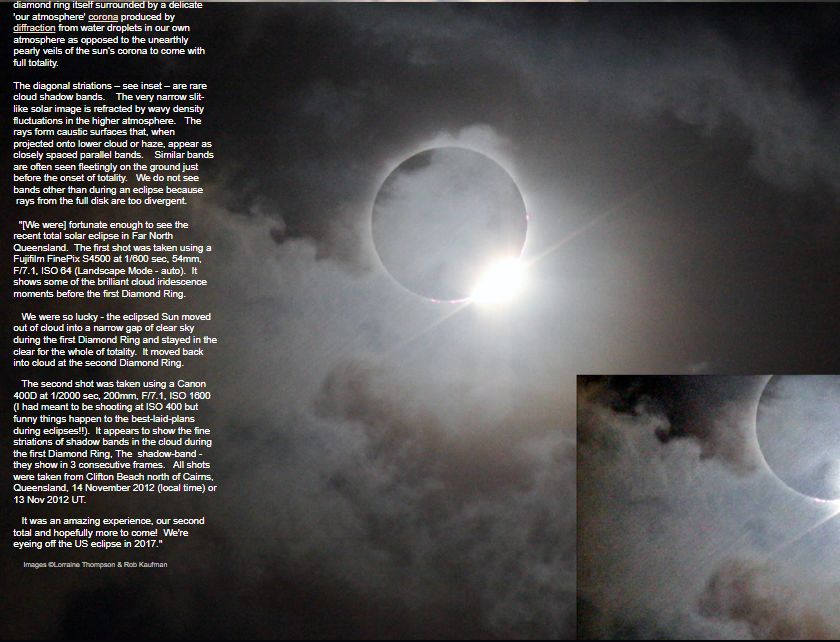OPOD - Eclipse Optics, Shadow Bands
OPOD - Eclipse Optics, Shadow Bands
The recent Australian solar eclipse provided a captivating display of atmospheric optics, including stunning iridescence and rare shadow bands. The images captured during this event offer a glimpse into the mesmerizing phenomena that occur during an eclipse. Let's delve deeper into the intricacies of eclipse optics and explore the fascinating world of shadow bands.
Iridescence and Diamond Rings
Lorraine Thompson's photograph showcases the enchanting iridescence of the clouds surrounding the sun, with the celestial body appearing as an ethereal narrow crescent. This colorful display is a result of the diffraction of sunlight by water droplets in our atmosphere. Unlike the sun's corona, which exhibits pearly veils during totality, the corona produced by our atmosphere creates a delicate, iridescent glow.
Rob Kaufman's image captures the mesmerizing moment of the first diamond ring. As the moon aligns perfectly with the sun, a brilliant burst of light emerges, resembling a diamond ring. The contrast between the celestial corona and the earthly iridescence adds to the allure of this celestial event.
Unveiling Shadow Bands
In addition to the captivating iridescence and diamond rings, Rob Kaufman's photograph reveals a rare phenomenon known as shadow bands. These diagonal striations, visible as closely spaced parallel bands, are caused by wavy density fluctuations in the higher atmosphere refracting the narrow solar image. When these rays are projected onto lower clouds or haze, they create these elusive patterns.
Shadow bands are typically observed just before the onset of totality. However, they are not visible during regular daylight due to the divergent nature of sunlight. The unique alignment of the moon and sun during an eclipse allows for these ethereal bands to manifest, providing observers with a truly remarkable sight.
The Nature of Shadow Bands
Shadow bands are a result of the interaction between the narrow solar image and the atmospheric conditions. When the rays from the sun, refracted by the wavy density fluctuations in the higher atmosphere, reach lower cloud or haze, they form caustic surfaces. These caustic surfaces, projected onto the clouds, manifest as closely spaced parallel bands.
The fleeting nature of shadow bands adds to their allure. They are often observed only for a brief moment on the ground just before the totality phase of an eclipse. The rarity and transient nature of these bands make them a sought-after sight for eclipse enthusiasts.
The Australian Solar Eclipse Experience
The fortunate observers of the recent total solar eclipse in Far North Queensland, Australia, were treated to a truly remarkable experience. Lorraine Thompson and Rob Kaufman captured the breathtaking moments leading up to and during the first diamond ring. Their photographs showcase the interplay between atmospheric phenomena and celestial events, offering a unique perspective on the beauty of our natural world.
The Magic Continues
The awe-inspiring display witnessed during the Australian solar eclipse serves as a reminder of the wonders that await us during future astronomical events. As we eagerly anticipate the upcoming total solar eclipse in the United States in 2017, we can only imagine the enchanting optical phenomena that will accompany it. Whether it's the iridescence of clouds or the elusive shadow bands, each eclipse provides an opportunity to marvel at the intricacies of our atmosphere and the cosmos beyond.

Eclipse Optics - Shadow Bands
Clouds at the recent Australian solar eclipse compensated with colourful iridescence and rare shadow bands.
Top: Lorraine Thompson pictured brilliant iridescent clouds with the sun an unreal narrow crescent and the first diamond ring soon to flash forth.
Lower: Rob Kaufman captured the first diamond ring itself surrounded by a delicate 'our atmosphere' corona produced by diffraction from water droplets in our own atmosphere as opposed to the unearthly pearly veils of the sun’s corona to come with full totality.
The diagonal striations – see inset – are rare cloud shadow bands. The very narrow slit-like solar image is refracted by wavy density fluctuations in the higher atmosphere. The rays form caustic surfaces that, when projected onto lower cloud or haze, appear as closely spaced parallel bands. Similar bands are often seen fleetingly on the ground just before the onset of totality. We do not see bands other than during an eclipse because rays from the full disk are too divergent.
".We were. fortunate enough to see the recent total solar eclipse in Far North Queensland. The first shot was taken using a Fujifilm FinePix S4500 at 1/600 sec, 54mm, F/7.1, ISO 64 (Landscape Mode - auto). It shows some of the brilliant cloud iridescence moments before the first Diamond Ring.
We were so lucky - the eclipsed Sun moved out of cloud into a narrow gap of clear sky during the first Diamond Ring and stayed in the clear for the whole of totality. It moved back into cloud at the second Diamond Ring.
The second shot was taken using a Canon 400D at 1/2000 sec, 200mm, F/7.1, ISO 1600 (I had meant to be shooting at ISO 400 but funny things happen to the best-laid-plans during eclipses!!). It appears to show the fine striations of shadow bands in the cloud during the first Diamond Ring, The shadow-band - they show in 3 consecutive frames. All shots were taken from Clifton Beach north of Cairns, Queensland, 14 November 2012 (local time) or 13 Nov 2012 UT.
It was an amazing experience, our second total and hopefully more to come! We're eyeing off the US eclipse in 2017."
Images ©Lorraine Thompson & Rob Kaufman

Note: this article has been automatically converted from the old site and may not appear as intended. You can find the original article here.
Reference Atmospheric Optics
If you use any of the definitions, information, or data presented on Atmospheric Optics, please copy the link or reference below to properly credit us as the reference source. Thank you!
-
<a href="https://atoptics.co.uk/blog/opod-eclipse-optics-shadow-bands/">OPOD - Eclipse Optics, Shadow Bands</a>
-
"OPOD - Eclipse Optics, Shadow Bands". Atmospheric Optics. Accessed on November 26, 2024. https://atoptics.co.uk/blog/opod-eclipse-optics-shadow-bands/.
-
"OPOD - Eclipse Optics, Shadow Bands". Atmospheric Optics, https://atoptics.co.uk/blog/opod-eclipse-optics-shadow-bands/. Accessed 26 November, 2024
-
OPOD - Eclipse Optics, Shadow Bands. Atmospheric Optics. Retrieved from https://atoptics.co.uk/blog/opod-eclipse-optics-shadow-bands/.